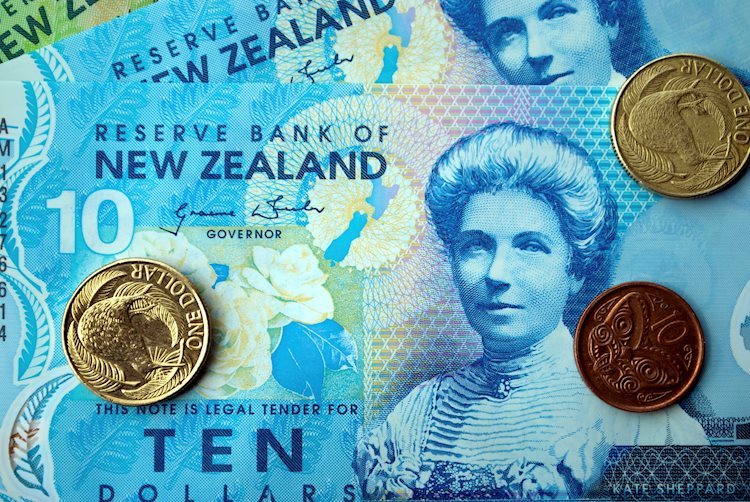- NZD/USD loses ground due to “Trump trades” and less dovish comments from Fed officials.
- Fed’s Alberto Musalem stated that persistent inflationary pressures force the Fed to halt its rate-cutting strategy.
- RBNZ expects to deliver a bumper 75 basis point rate cut in November as the inflation rate eases.
NZD/USD extends its decline for the third consecutive day, trading near 0.5870, marking a three-month low during Thursday’s Asian session. The pair’s downward movement is largely due to the strengthening US Dollar (USD), fueled by “Trump trades” and less dovish remarks from Federal Reserve (Fed) officials following US inflation data.
The US Dollar Index (DXY), which measures the value of the US Dollar against its six major peers, holds steady around 106.60, its highest level since November 2023, supported by rising US Treasury yields. At the time of writing, the 2-year and 10-year US Treasury yields are at 4.31% and 4.47%, respectively.
On Wednesday, St. Louis Fed President Alberto Musalem remarked that ongoing inflationary pressures make it challenging for the Fed to maintain a course of rate cuts. Musalem shifted focus to the robustness of the US labor market, aiming to ease concerns about inflation’s resistance to the Fed’s efforts to reduce it. Meanwhile, Kansas City Fed President Jeffrey Schmid emphasized the potential hurdles in the path toward lowering interest rates.
The US Consumer Price Index (CPI) rose by 2.6% year-over-year in October, matching market expectations, following a 2.4% increase in the previous month. Meanwhile, the core CPI, which excludes the more volatile food and energy sectors, climbed by 3.3%, in line with forecasts.
The Reserve Bank of New Zealand (RBNZ) is anticipated to announce a more substantial 75 basis point rate cut later this month as the inflation rate eases to its lowest level since Q1 2021 in the third quarter. A 50 basis point cut has already been fully priced in by markets.
However, the Food Price Index in New Zealand remained steady at 1.2% year-over-year in October, marking the highest level since February. On a monthly basis, food prices dropped by 0.9% in October, following a 0.5% increase the previous month.
Traders are now focusing on the upcoming US October Producer Price Index (PPI) data, scheduled for release on Thursday. Market participants are also looking ahead to the release of Industrial Production and Retail Sales data for October from China, New Zealand’s largest trading partner, which is due on Friday.
New Zealand Dollar FAQs
The New Zealand Dollar (NZD), also known as the Kiwi, is a well-known traded currency among investors. Its value is broadly determined by the health of the New Zealand economy and the country’s central bank policy. Still, there are some unique particularities that also can make NZD move. The performance of the Chinese economy tends to move the Kiwi because China is New Zealand’s biggest trading partner. Bad news for the Chinese economy likely means less New Zealand exports to the country, hitting the economy and thus its currency. Another factor moving NZD is dairy prices as the dairy industry is New Zealand’s main export. High dairy prices boost export income, contributing positively to the economy and thus to the NZD.
The Reserve Bank of New Zealand (RBNZ) aims to achieve and maintain an inflation rate between 1% and 3% over the medium term, with a focus to keep it near the 2% mid-point. To this end, the bank sets an appropriate level of interest rates. When inflation is too high, the RBNZ will increase interest rates to cool the economy, but the move will also make bond yields higher, increasing investors’ appeal to invest in the country and thus boosting NZD. On the contrary, lower interest rates tend to weaken NZD. The so-called rate differential, or how rates in New Zealand are or are expected to be compared to the ones set by the US Federal Reserve, can also play a key role in moving the NZD/USD pair.
Macroeconomic data releases in New Zealand are key to assess the state of the economy and can impact the New Zealand Dollar’s (NZD) valuation. A strong economy, based on high economic growth, low unemployment and high confidence is good for NZD. High economic growth attracts foreign investment and may encourage the Reserve Bank of New Zealand to increase interest rates, if this economic strength comes together with elevated inflation. Conversely, if economic data is weak, NZD is likely to depreciate.
The New Zealand Dollar (NZD) tends to strengthen during risk-on periods, or when investors perceive that broader market risks are low and are optimistic about growth. This tends to lead to a more favorable outlook for commodities and so-called ‘commodity currencies’ such as the Kiwi. Conversely, NZD tends to weaken at times of market turbulence or economic uncertainty as investors tend to sell higher-risk assets and flee to the more-stable safe havens.
Read the full article here

